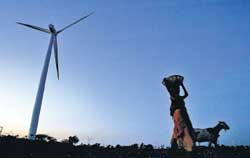
Coal is still king, but wind energy grows in IndiaSINBAN, India (AP) - The wind farm is visible from miles (kilometres) away, a forest of looming turbines churning in the afternoon breeze, rising incongruously above fields of barley, corn and sunflowers."This is the only future for the long-term," says Tulsi Tanti, 49, a one-time yarn manufacturer who turned a small wind energy sideline into the sprawling corporation Suzlon, and turned himself into a billionaire in the process.
If wind power has a reputation of being on the fringes - an expensive technology that has more to do with environmentalist dreams than electricity production - India is also proving it to be a viable energy source, even in the developing world. India has the fourth-highest installed capacity for wind power in the world, lagging only Germany, Spain and the United States, according to the Global Wind Energy Council. Wind, like solar and other renewable energy sources, still faces major hurdles. In India, it costs a wind farm about 7 U.S. cents to produce a kilowatt-hour of electricity - approximately 50 percent more than coal, according to the New Delhi-based Energy and Resources Institute. As in most countries, wind energy is supported by tax breaks and subsidies that make it competitive. Even Tanti acknowledges wind isn't going to replace coal - which today supplies about 65 percent of India's electricity - anytime soon. But the cost of wind has dropped dramatically in the past decade, in some cases by more than half, and is expected to drop further as the technology advances. And coal could become more expensive if global warming forces countries to adopt costly methods to reduce the pollution it generates. About 2 percent of India's power comes from wind but, as costs drop, that could reach 12 percent, experts say. "It's a serious energy source, as far as India is concerned," says Mahesh Vipradas, a fellow at the Energy and Resources Institute. One thing is certain: India needs more energy. With 1.1 billion people and an economy growing at close to 9 percent per year, the country is fast becoming one of the world's largest energy consumers. Experts estimate the country has 10 percent to 12 percent less power than it needs. Blackouts are common, even in the largest cities, and hot summer nights can find millions of people sleeping on rooftops, praying for a breeze because their fans and air conditioning won't go on. "The whole world needs more and more energy, that is the topmost priority for any economic growth," Tulsi says during an interview in the Suzlon office in Pune, a western Indian city. "Any one source - or any two, three sources - cannot satisfy this demand." That's where wind comes in. Three years ago, India had about 2,500 megawatts of wind capacity installed. Today, that has reached more than 7,000 megawatts - enough to power some 30 million homes. The Indian government has pushed the wind business with tax breaks on windmills, which can cost upwards of US$1.2 million (euro850,000) apiece, and mandates that states get a percentage of their electricity from renewable sources. All this has been a big boost to Suzlon, by far the biggest wind player in the country. Tanti and his brothers founded the company in 1995, stumbling into the business after the local power grid couldn't keep their textile factory going. They purchased a couple windmills and soon left textiles behind. In recent years, the business has grown about 100 percent annually, swallowing up other companies and raking in profits. The company recently moved its global marketing headquarters to Denmark, but the India operations are still run from Pune. Suzlon, with a market capitalization of more than US$9 billion (euro6.4 billion), has become the world's fifth-largest wind turbine manufacturer, with operations in Germany, China and Pipestone, Minnesota, where it makes turbine blades and other parts. Here, in the hills of eastern India, it operates one of the largest wind farms in the world: more than 500 windmills on 1,300 acres (526 hectares), sprawling across hills, villages and roads and generating more than 600 megawatts of electricity. The blades of the soaring white machines - the tallest ones are 74 metres (81 yards) high - cast shadows that slash across the fields. |
|| Front
Page | News | Editorial | Columns | Sports | Plus | Financial
Times | International | Mirror | TV
Times | Funday
Times || |
| |
Reproduction of articles permitted when used without any alterations to contents and the source. |
© Copyright
2007 Wijeya
Newspapers Ltd.Colombo. Sri Lanka. All Rights Reserved. |
